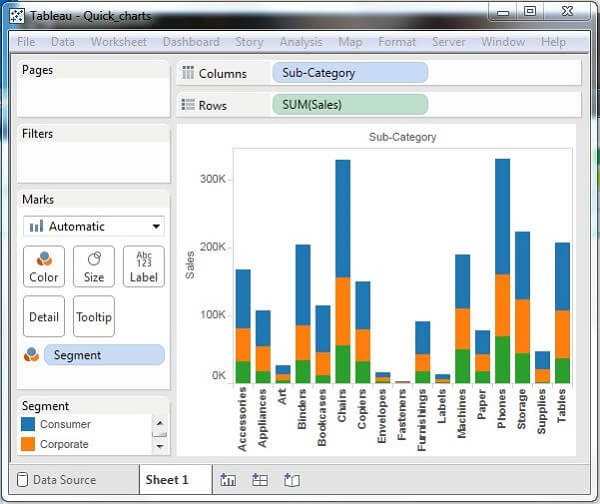
Bar chart:
A bar chart represents the data in rectangular bars with the length of the bar proportional to the values of the variable. Tableau naturally creates a bar chart when you drag a measurement to the Row shelf and measure to the Column shelf . We can likewise utilize the bar diagram alternative present in the Show Me button . If the information isn't proper for bar diagram, at that point this alternative will be naturally turned gray out. Types of bar charts.
Get in touch with OnlineITGuru for mastering the Tableau Online Training
Simple Bar Chart:
From the Sample-Superstore, pick the dimension, take the profit to the columns shelf and Sub-Category to the lines shelf . It consequently creates a horizontal bar graph as appeared in the following screenshot.
Bar Chart with Color Range:
You can apply colors to the bars in view of their ranges. The longer bars get darker shades and the shorter bars get the lighter shades. To do this, drag the profit field to the color palette under the Marks Pane. Additionally take note of that, it creates an alternate color for negative bars.
Stacked Bar Chart:
You can add another measurement to the above bar graph to deliver a stacked bar outline, which demonstrates distinctive colors in each bar. Drag the measurement field named segment to the Marks pane and drop it in colors. The following chart shows the dissemination of each fragment in each bar.
Bubble chart :
Bubble chart display data as a group of circles. Each of the values in the dimension field represents to a circle while the values of measure represent the size of those circles. As the values are not going to be displayed in any line or column , you can drag the required fields to various shelves under the marks card.
Check the Tableau top interview questions to clear the certification exams now
Simple Bubble Chart:
Utilizing the Sample-superstore, we should plan to locate the size of profits for various ship mode. To accomplish this target, following are the steps.
Stage 1 − Drag and drop the measure profit into the Size shelf under Marks card.
Stage 2 − Drag and drop the dimension ship mode into the Labels shelf under Marks card.
Stage3 − Pull the dimension ship mode to the Colors shelf under Marks card.
Bubble Chart with Measure Values:
You can also demonstrate the estimations of the measure field which chooses the sizes of the circles. To do this, drag the sales measure into the Labels shelf. The accompanying chart appears.
Bubble Chart with Measure Colors:
Instead of coloring each circle with an different color , you can utilize a single color shading with various shades. For this, drag the measure sales into the color shelf . The higher values speak to darker shades while the lower values speak to lighter shades.
Bump Chart :
A Bump Chart is utilized to compare two dimensions against each other utilizing one of the Measure value . They are extremely useful for investigating the changes in Rank of an value over a time dimension or some other measurement pertinent to the analysis .
The Bump Chart brings two dimensions with at least zero or more measures.Creating a Bump Chart:
Utilizing the Sample-superstore, plan to discover the variety of ship method of items with the variety of the Sub-Category. To accomplish this goal, following are the steps.
Step 1 − Intuitive the measurement Sub-Category to the Columns shelf . Likewise drag the dimension Ship mode to the Color shelf under Marks card. Leave the diagram sort to Automatic. The accompanying chart appears.
Step 2- Next, make an calculated field called Rank. Go to Analysis → Create Calculated Field. Utilize Rank as the field name and compose the expression index () in the calculation area . It is an inbuilt function that makes a list for the present row in the partition . Click OK and the new field will be obvious in the measures section . Right-click on the field Rank and change over it to discrete.
Step 3- Drag Rank to the Rows shelf . The accompanying graph shows up which demonstrates the dimension Sub-Category with each ship mode masterminded in an expanding request of their Rank value.
Stage 4 − Apply some more calculation to the rank field utilizing the measure Profit. Right click on Rank and pick Edit Table calculation . Choose the sorting by the field benefit utilizing partition by Sub-Category and addressed by deliver mode. The accompanying screenshot demonstrates the calculations connected.
Water Fall Chart :
Waterfall charts effectively show the combined impact of successive positive and negative values . It demonstrates where an esteem begins, finishes and how it arrives incrementally. Thus, we can see both the span of changes and contrast in values between consecutive data points.
Creating a Waterfall Chart:
Utilizing the Sample-superstore, plan to discover the variety of Sales for each Sub-Category of Products. To accomplish this target, following are the steps.
Step 1 − Drag the Dimension Sub-Category to the Columns shelf and the Measure Shelf to the Rows shelf. Sort the information in a rising request of sales value. For this, use the sort choice showing up amidst the vertical axis when you drift the mouse over it. The accompanying diagram shows up on finishing this step.
Get in touch with OnlineITGuru for mastering the Tableau Online Training
Stage 2 − Next, right-click on the SUM (Sales) value and select the running aggregate from the table estimation choice. Change the diagram type to Gantt Bar. The following graph shows up.
Step 3 − Create a calculated field named - deals and say the following for its value.
Step 4 - Drag the recently made computed field (- deals) to the size retire under Marks Card. The outline above now changes to deliver the following chart which is a Waterfall graph.












